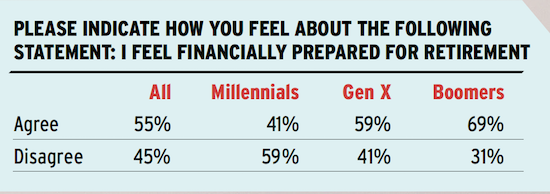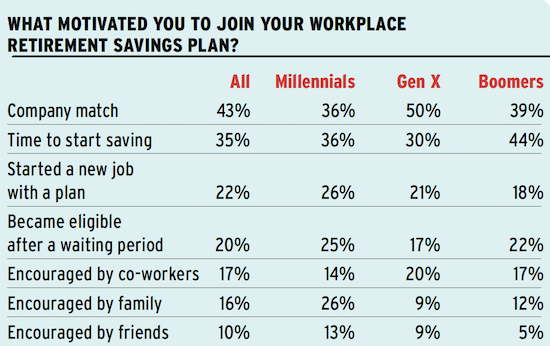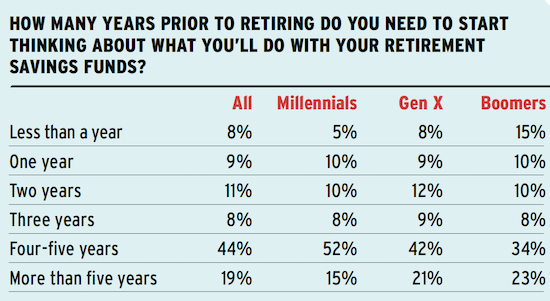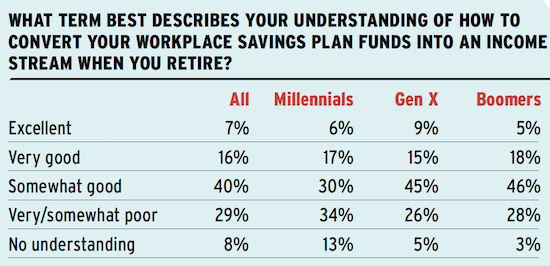

Though more than half of Canadian capital accumulation plan members feel financially prepared for retirement, there’s a distinct difference across generations. Given their proximity to retirement, it’s no surprise baby boomers (69 per cent) are the age cohort most likely to agree they feel prepared, compared to 59 per cent of generation X and 41 per cent of millennials. But are people overconfident about their financial preparedness, and what steps can pension plan sponsors take to help bring them back to reality?
In this year’s CAP Member Survey, supported by Actuarial Solutions Inc., Benefits Canada asked millennials, genXers and baby boomers participating in a workplace defined contribution plan, registered retirement savings plan or tax-free savings plan about their retirement readiness, financial and investment savvy and what they need from their employers.
Read: Disconnect between baby boomer, employer perspectives on working in retirement: survey
While 20 per cent of all respondents are in an employer-sponsored defined benefit plan, around a third of each age cohort are in a DC plan, two-thirds are in a group RRSP and less than 20 per cent are in a group TFSA.
With changing workforce demographics, evolving pension plan design and different financial priorities across age groups, the issue of retirement readiness is growing into a global concern.
Speaking on a panel about the survey results at Benefits Canada’s 2019 Benefits and Pension Summit in April, Michael Dodd, director of pensions, treasury and shareholder services at the Co-operators Group Ltd., said boomers are the age group that most often comes into his office to ask questions. “I do feel they’re more aware of retirement, for obvious reasons,” he said. “And so, for me, the results of being prepared goes up in the line: the older people get, the more prepared they feel.”
On the other hand, millennials are focusing on different financial priorities, such as student debt and home ownership, noted Karen Burnett, senior director of retirement at Willis Towers Watson. “So they don’t have that confidence in the longer term. They aren’t looking at retirement the same way we did. . . . They have that total different mindset than boomers.”
Read: Surveys show pension concerns for both Canadian millennials, seniors
In addition to these perceptions of financial readiness, 71 per cent of all respondents said they’re confident their employer-sponsored plan will provide them with the amount of money they expect to meet their financial obligations in retirement. Here, millennials (66 per cent) are slightly less confident than gen X (74 per cent) and boomers (74 per cent).

It’s likely millennials’ lack of confidence ties back to the fact they’re not yet paying attention to retirement, said Burnett, noting she’s surprised by the relatively high level of confidence across all age groups in response to this question.
“When we work with plan sponsors and talk to their employees, when you actually bring up the concept of retirement and the plan and what they need in retirement, what they say and what they actually mean are very different. A lot of this would point to education and making people more aware of what income they actually need in retirement rather than this ficticious ‘I think I’m going to be OK.’”
As well, this response may be related to millennials’ loyalty to their employer, said Dodd. “I wonder if that factors into their view. They may not be relying on the company for their retirement plan and they may have different ideas about that.”
Keep it simple
Despite overall high expectations for their standard of living in retirement, 14 per cent of all survey respondents said they expect they’ll need financial support from family and friends. This number peaked at 19 per cent for generation X, followed by 12 per cent among millennials and just six per cent among boomers.
The panel agreed this isn’t a surprise given the current low interest rate environment and younger generations’ competing financial priorities. “GenXers‚ in particular, we call them the sandwich generation, because they’ve got it from both ends of the spectrum where they’re dealing with childcare issues as well as elder care and just the craziness of day-to-day living,” said Kim Duxbury, executive client partner in group retirement services at Sun Life Financial. “And it’s really tough for that generation to have work-family balance. So anything the employer can do to simplify decision-making, simplify choices and the stress that generation feels, is extremely valued.”
Read: Holistic retirement thinking: Integrating public and private pensions
Dodd highlighted the onus on employers to ensure members understand what the workplace pension plan is intended to do. “So it’s not necessarily intended to be 100 per cent retirement replacement. We’ve got [the Canada Pension Plan]. We’ve got [old-age security]. I think plan sponsors have some ownership here to make sure members understand that the pension plan, particularly a DC plan, may not be 100 per cent . . . Make sure you take a holistic viewpoint and be aware of that.”
The panel also noted the importance of engaging employees as early as possible in their careers, particularly to encourage good financial behaviour. “If you can do that early, you are going to set them up for the rest of their lives,” said Janice Holman, principal at Eckler Ltd. “They’re going to be more financially mindful and aware and cautious. You have to do that and you have to adjust your approach based on who the demographic is that you have in your population. One solution for everybody isn’t going to work at that point in time.”
One option is for employers to look at any eligibility restrictions in their plan, said Duxbury. “You hire a millennial. They get that first paycheque and they adjust their standard of living to align with their paycheque. And then, if you have a six-month waiting period, now you’re going to say, ‘You can join this great workplace plan we have.’ But now they have to give up something they’ve been spending their money on for the last six months.
“When I work with clients, I often challenge them, ‘Why do you have that waiting period?’ You can get better adoption if, out of the gate, their first day of work, [you can] get them in the plan before they get that first paycheque, and then you’re setting them up . . . on that right path to success.”
Read: Eliminating ‘tyranny of choice’ in DC plan enrolment
Burnett agreed, noting it’s ideal for plan sponsors to include CAP enrolment as part of the onboarding process, so members can sign up at the same time they’re joining their benefits plan, for instance.
It’s a match
When survey respondents were thinking about joining their employer-sponsored CAP, the majority (58 per cent) of all age groups considered their age and the number of years until retirement. This was followed by current savings (38 per cent), impact on take-home pay (34 per cent), fluctuations in financial markets or the likelihood of investment losses (25 per cent), government pension (24 per cent) and other expected sources of retirement income (24 per cent).
But when asked what motivated them to finally join the plan, 43 per cent of all respondents cited the company match, while 35 per cent said they realized it was time to start saving, followed by starting a new job that offered a plan (22 per cent), becoming eligible after a waiting period (20 per cent) and receiving encouragement from co-workers (17 per cent), family members (16 per cent) or friends (10 per cent).

During the panel discussion, Holman agreed a company match is the most common design in CAPs, noting it’s a successful way to encourage members to contribute. But this doesn’t mean a 100 per cent match is necessary. “I think any match is helpful to get people to participate in the plan,” she said. “But you need to look at your workforce and figure out what savings level is appropriate for the majority of your members, and then design your plan to get to that total level.”
Read: 28% of Canadian gen-Xers have no retirement savings, survey finds
In terms of trends, Holman noted a lot of plan sponsors have a base, mandatory employee contribution they match. “And so, as an employer, you know everybody is going to have a certain minimal amount in retirement savings . . . and then have additional matching beyond that that provides the employee with the flexibility to save the amount that’s appropriate to them, because not everybody is the same.”
While Duxbury said she also sees plan members enbracing the concept of a match, Sun Life has found the word “match” doesn’t resonate with a lot of Canadians. “They don’t quite understand exactly what that means.”
Also, while Canadian workplace plans most commonly offer a base, or starter, employer contribution, it’s more common in the U.S. to see a stretch match. “Where here in Canada, most employers seem to think you need to match dollar for dollar or fifty cents on the dollar . . . in the U.S., you can have fifty cents on the first X per cent of earnings and then dollar for dollar on the next Y per cent . . . you can use that to manage the employer’s cost, but you can also use it to drive up savings rates.”
Read: Plan sponsor panel: Customizing plan design, communication key for DC members
Joe Nunes, executive chairman at Actuarial Solutions, said he’s not a fan of matching at all. “I think the best design is five and five, mandatory, or seven to seven, mandatory. And just tell everyone, ‘You have to contribute or you’re not going to get to retirement. We’re going to contribute and you’re going to do your part and away we go.’ But I don’t think a lot of chief financial officers are going to like the way I think, because some organizations save money at the expense of people who live paycheque to paycheque and just won’t let go of that money.”
New decumulation options
Across all generations, the survey found 34 per cent of CAP members believe they should start focusing on how to use their savings about four or five years before retirement. All generations agreed here, at 52 per cent for millennials, 42 per cent for generation X and 34 per cent for boomers.
Duxbury disagreed, noting Sun Life has seen spikes at age 50, 55 and 60. Boomers, especially those who haven’t connected with their CAP provider or have moderate usage of the website or tools, have tended to get in touch at age 50, she said. “And then they’re more willing to listen, to be engaged.”

There’s another spike at age 55, added Duxbury. “So as they get closer and closer [to retirement], you can start to have those conversations. Fifty-five, we tend to start having conversations with spouses as well. It’s getting a bit more serious. And then at 60, 62, that’s when they really start getting much more serious. . . .”
However, when it comes to actually converting retirement savings accounts into an income stream, only 23 per cent of survey respondents said they feel they have an excellent or very good understanding of how to do so when they retire. This is fairly consistent across the three generations surveyed.
Read: Industry praises budget proposals to allow variable annuities for CAP members
Holman noted new decumulation products will be available for CAP members, referring to the federal government’s recent budget proposal to amend the tax rules to allow for late-life and variable annuity structures. The annuity would be a qualifying purchase under RRSP savings and registered retirement income funds, including trusts run by these accounts, as well as DC plans, among others.
“We’re pretty excited at the Co-operators about the potential of variable annuities,” said Dodd, during the panel discussion.
Realistic projections
So rather than projecting for a specific gross income replacement ratio or pot of money, plan members should be asking what amount they need to maintain their standard of living in retirement, said Burnett. She noted pot size is going to be much different depending on economic conditions and how members plan to use the pot in retirement.
Read: CAPSA updates guidelines on DC plan payout, responsibilities and advice
“If you looked at someone who had a $200,000 pot of money 18 years ago, that leant to a much better retirement income than someone who has $200,000 today,” she said. “So giving employees a dollar amount to accumulate at retirement doesn’t really give the answer of when they will be able to retire and maintain their standard of living.”
When plan members look at their future retirement as income, they’re often overly optimistic or not doing it the right way, noted Duxbury.
“When I’m speaking with plan sponsors and they’re trying to help their employees plan for retirement and they’re using tools, we’ve gone very far away from allowing members to put in what they think their rate of return on their DC account balance is going to be, because they tend to say 15 per cent a year . . . Taking that away from them and saying we’ll do that calculation, that gives them a better picture. People who are doing it on their own are likely putting in unreasonable assumptions and being very unrealistic about what the future is going to hold.”

While most (39 per cent) survey respondents said they meet in-person with a financial advisor to create a formal, documented financial plan, a similar percentage (36 per cent) are using online tools and 14 per cent are using mobile apps.
Breaking these findings down among the three surveyed generations, 66 per cent of baby boomers use an in-person financial advisor, compared to 35 per cent of millennials and 28 per cent of gen-Xers. And those numbers reverse when looking at online and mobile tools. Millennials (42 per cent) and gen-Xers (38 per cent) are more likely than boomers (26 per cent) to use the web. And the margin is even narrower for mobile apps, with only one per cent of boomers saying they use them, compared to 24 per cent of millennials and 15 per cent of gen-Xers.
Read: Key steps to engaging baby boomers in retirement
While the prevalence of technology among younger generations shows they’re at least thinking about retirement savings, Holman noted gen-Xers seemed to have the most worrying answers throughout the survey. “These are the ones who should be really starting to think about it, have some idea what they’re going to do. I worry about the craziness of today, the new sandwich generation that we’re in. The conversion from DB to DC is affecting that group. Maybe they got a bit lost in the shuffle and haven’t adjusted to the expectations of today.
“To me, if I’m an employer, I’d be very concerned about that group.”
One idea is encouraging older generations to champion the importance of retirement savings and pass that message on to younger employees, said Dodd. “Older people or more mature people going to the young people and saying, ‘Make sure you sign up for the pension plan.’ That’s actually worked well for us.”
Jennifer Paterson is editor of Benefits Canada.
